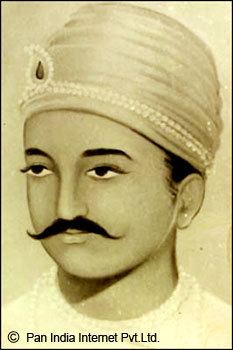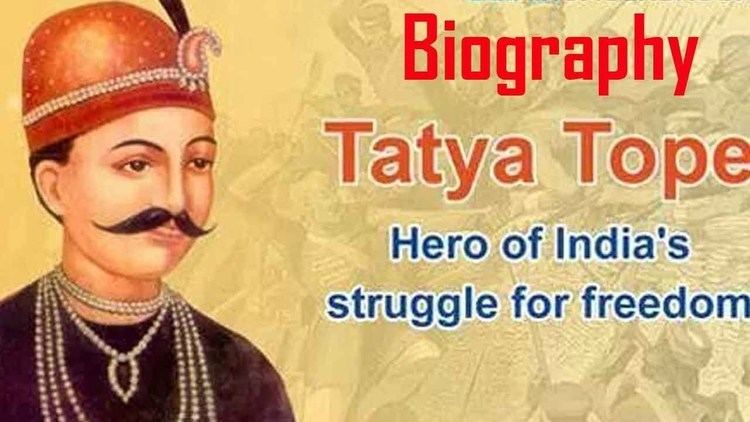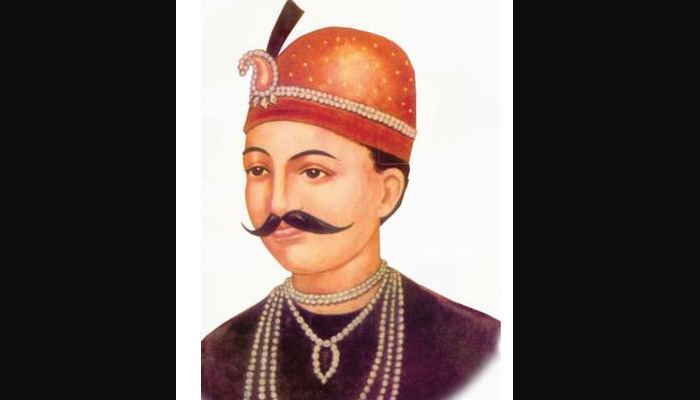Religion Hindu Name Tatya Tope | Role Political leader | |
 | ||
Other names Tantya Tope, Tantia Topi Parents Rukhmabai, Pandurang Rao Tope Similar People Nana Sahib, Rani of Jhansi, Begum Hazrat Mahal, Bahadur Shah II, Baji Rao II | ||
Discourse - Tatya Tope and First War of Independence
Tantia Tope (1814 – 18 April 1859) was a general in the Indian Rebellion of 1857 and one of its notable leaders. He was born as Ramachandra Panduranga to a Maratha Brahman family and took on the title Tope, meaning commanding officer.
Contents
- Discourse Tatya Tope and First War of Independence
- SAPAKS workers purify Tatya Topes statue after Amit Shah paid tribute at memorial
- Personal life
- Role in the 1857 Revolt
- References

A personal adherent of Nana Sahib of Bithur, he progressed with the Gwalior contingent after the British reoccupied Kanpur and forced General Windham to retreat from the city. Later on, he came to the relief of Rani Lakshmi of Jhansi and with her seized the city of Gwalior. However, he was defeated by General Napier's British Indian troops at Ranod and after a further defeat at Sikar abandoned the campaign. He was executed by the British Government at Shivpuri on 18 April 1859.

SAPAKS workers purify Tatya Tope’s statue after Amit Shah paid tribute at memorial
Personal life

Not much is known about Tantia Tope's personal life except for short accounts in Hindi and Marathi. The ones in English are mostly historical accounts of the Indian Rebellion of 1857. Tantia Tope was born as Ramachandra Panduranga and took on the title Tope, meaning commanding officer, probably derived from Tope, Hindi for cannon or artillery. According to an official statement, Tantia Tope's father was Panduranga, an inhabitant of Jola Pargannah, Patoda Zilla Nagar, in present-day Maharashtra. Tope was a Maraṭha Vashista Brahman by birth. In a government letter, he was said to be the minister of Baroda, while he was held identical to Nana Sahib in another communication. A witness at his trial described Tantia Tope as 'a man of middling stature, with a wheat complexion and always wearing a white chukri-dar turban.'
Role in the 1857 Revolt

After the uprising in Cawnpore took place on 5 June 1857, Nana Sahib became the leader of the rebels. The British forces surrendered on 25 June 1857 and were evacuated to the Satichaura Ghat on the river, where they were massacred. Nana was declared Peshwa in late June. General Havelock fought with Nana's forces in battle two times, they were defeated the third time and withdrew to Bithur, after which he crossed the Ganges and retreated to Awadh. Tantia Tope began to act in Nana Sahib's name from Bithur. Nana Sahib decided to use the captives for bargaining with the British. The Company forces from Allahabad, under the command of General Henry Havelock, advanced relentlessly towards Cawnpore. Two forces sent by Nana Sahib to check their advance were defeated. When it became clear that the bargaining attempts had failed, an order was given to murder the women and children imprisoned at Bibighar, on 15 July. The details of the incident, such as who ordered the massacre, are not clear, but it is widely believed Tantia Tope gave the order.
After losing Gwalior to the British, Tope and Rao Sahib, nephew of Nana Sahib, fled into the Rajputana. He was able to induce the army of Tonk to join him. He was unable to enter the town of Bundi and though announcing he would go south in fact went west towards Nimach. A British flying column commanded by Colonel Holmes was in pursuit of him and the British commander in Rajputana, General Abraham Robert was able to attack the rebel force when they had reached a position between Sanganer and Bhilwara. Tope again fled from the field towards Udaipur and, after visiting a Hindu shrine on 13 August, he drew up his forces on the Banas River. They were defeated again by Roberts's forces and Tope fled. He crossed the Chambal River and reached the town of Jhalrapatan in the state of Jhalawar. He induced the state forces to rebel against the raja and was able to replace the artillery he had lost at the Banas River. Tope then took his forces towards Indore but was pursued by the British now commanded by General John Michel as he fled towards Sironj. He was still accompanied by Rao Sahib and they decided to divide their forces so that Tope could move to Chanderi, and Rao Sahib, with a smaller force, to Jhansi. However they combined again in October and suffered another defeat at Chota Udaipur. By January 1859 they were in the state of Jaipur and experienced two more defeats. Tope then escaped alone into the jungles of Paron. At this point he met Man Singh, raja of Narwar, and his household and decided to stay with them. Man Singh was in dispute with the maharaja of Gwalior and the British were successful in negotiating with him to surrender to them in return for his life and protection of his family from any reprisals by the maharaja. After this Tope was alone.

Tope admitted the charges brought before him saying that he was answerable to his master the Peshwa only. He was executed at the gallows on 18 April 1859.
